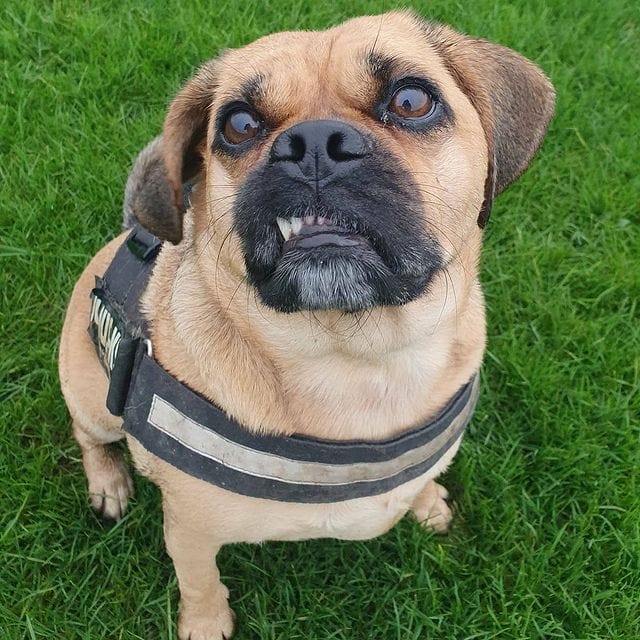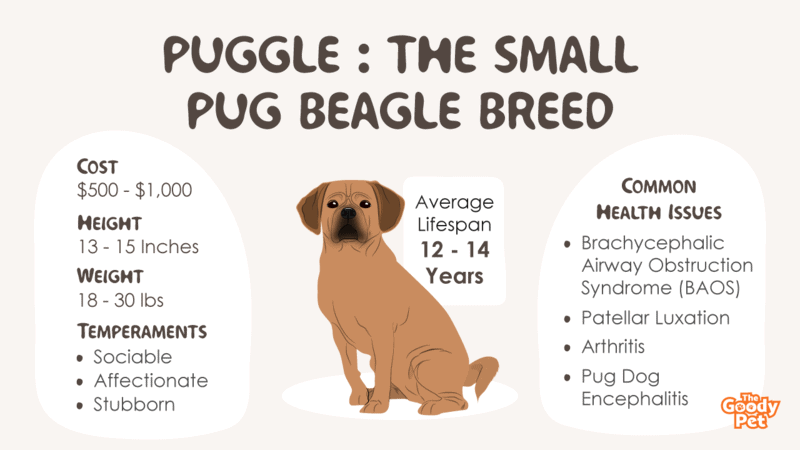Do you fancy a beautiful crossbreed doggie? In this post, we will take a look at a Puggle, a small designer dog with cute looks bred between a pug and a beagle. So, what is a Puggle?
A Puggle is a hybrid resulting from cross-breeding a Pug and a Beagle. Puggles are small to medium dogs with a lifespan of between 12 and 14 years with short double coats. Puggles have coat colors ranging from tan to black and have sociable, affectionate, and stubborn temperaments.
To help you understand this hybrid doggie, we will go deeper into their character traits, as well as look at some viral and bacterial diseases that are common in Puggles. To ensure that you get your money’s worth, read on to find the standard price of this pug-beagle crossbreed. What about grooming? We will definitely come to that in a bit, but let’s first find out what a Puggle looks like.
What Is A Puggle?

This Pug Beagle Mix does not have an official standard, with their appearance varying a lot. Generally, though, Puggles are slightly larger than Pugs with less wrinkly faces. They also come with a lean body, longer ears, and longer muzzles from their Beagle genes.
Depending on who you quote, there are two theories of how Puggles came about.
On one side, it’s thought that the cross was due to accidental breeding between the parent breeds.
And on the other hand, Puggles are said to have been bred in the United States with the goal of producing a dog with fewer behavioral and health issues, as seen in Pugs and Beagles.
Whatever the case, though, the hybrid that we now have is great in many ways.
When it comes to size, the question of whether a Puggle is a small or a medium dog arises often.
To answer this, let’s first look at the sizes of the parent breeds as well as the difference in weight between small and medium dogs:
- Pugs: 10 to 14 inches tall, 14 to 18 lbs heavy
- Beagles: 13 to 16 inches tall, 20 to 25 lbs heavy
- Small dogs: 12 to 25 lbs in weight
- Medium dogs: 25 to 50 lbs in weight
Now, Puggles grow more or less within the size range of their parent breeds.
Puggles are about 18 to 30 lbs in weight and 13 to 15 inches in height.
Also, as per the above size comparison, a Puggle can either be a small or a medium-sized dog.
Specifically, if your adult furry companion is below 25 lbs, then they are considered small and if their weight is between 25 and 30 lbs, then they are considered medium-sized.
Do Puggles Have Health Problems?
Despite the fact that designer dogs are developed to minimize undesirable traits common in pure breeds, Puggles do have health problems. These include:
Brachycephalic Airway Obstruction Syndrome (BAOS)
In particular, your furry buddy may experience breathing issues common in pugs. This is due to their heads being shorter, in comparison to their body.
Known as a brachycephalic head, the signature flat face leads to tiny nostrils, long and soft plates, and narrow-wide pipes. As such, your fido’s airways become obstructed easily, making them snore noisily and tire fast.
Patellar Luxation
This is a disease that attacks the kneecaps and is common in small dogs. The patellar, known simply as the kneecap, pops out of place.
This is brought about by jumping up and down a lot, especially in Puggles which are a little on the heavier side.
Patellar luxation also manifests in dogs suffering from hip dysplasia, another disease that is common in small and obese doggies.
Arthritis
Arthritis is another common disease in Puggles that usually plagues older dogs. Your furry companion will first be attacked by other diseases that affect the joints, such as hip dysplasia, which later develops into arthritis if not treated well.
Pug Dog Encephalitis
Although the above diseases can lower the lifespan of a puggle, they are not fatal.
On the other hand, Puggles usually die from rare neurological conditions such as encephalitis (inflammation of the brain). The disease is characterized by seizures that lead to death.
Without such afflictions, though, and with regular visits to the vet, your puggle can live healthily for a long time.
A typical puggle has a life expectancy of between 12 and 14 years.
Do Puggles Smell Bad? Grooming Tips For A Puggle

On the issue of grooming, we will go over some tips to ensure that you’re giving your Puggle the care they deserve.
But before we get to that, it’s worth noting that these fidos inherit skin folds on the face from the Pug side of their heritage.
Sweat and dirt get trapped on the folds, becoming breeding sites for foul-smelling bacteria. As such, unless they are kept clean, Puggles can smell bad.
On the same note, when your pooch is in heat, they tend to smell. This nasty smell results from a mixture of blood, endometrial tissue, and other body fluids being exposed to the air.
Another factor determines how dogs are groomed and what their shedding frequency is like.
Pugs and Beagles are heavy shedders, so expect Puggles to shed just as much, if not more. Shedding also comes with dander, an allergic mixture of dead skin, and oils from skin and fur.
This brings us to an important question.
Are Puggles Hypoallergenic?
Just like their parent breeds, Puggles are not hypoallergenic.
While no dog is 100% hypoallergenic, Puggles shed more than most dog breeds, and as such, they release more dander into the air and on surfaces that they come into contact with.
With that in mind, here are some Puggle grooming tips:
- Brush your Puggle once to twice a week or at least four times if you suffer from allergies.
- Use anti-allergen shampoo for bathing your Puggle monthly.
- Carefully clean the skin folds, especially on the face.
- When in heat, bathe your Puggle weekly or use antibacterial wipes to clean their rear daily.
Temperaments Of A Puggle
Caring for a dog is not just about grooming but also understanding its personality. The temperament of a Puggle is a mix of their parents’ behaviors. From the Pug side, Puggles are sweet, enthusiastic, and affectionate. They are also good-natured and playful, with boundless energy inherited from the Beagle side.
For more on what to expect from these four-legged furry friends, let’s address some temperament-related FAQs.

Do Puggles Like To Cuddle?
Puggles love to cuddle, a trait they have carried on from Pugs.
Though they are not perfect lapdogs like Pugs, most Puggles are okay with whiling their day snuggling and sleeping on your lap.
Can A Puggle Be Left Alone?
Puggles love human companionship. So much so that leaving them alone for long in the house can make them suffer from separation anxiety.
That said, with proper crate training, you can leave a Puggle alone for 8 hours per day.
Are Puggles Hard To Train?
True to their Pug parentage, Puggles are stubborn and difficult to train. Given a chance, they like playing the alpha dog and will not take lightly being given instructions. However, with patience and positive reinforcement, they can be trained.
Are Puggles Aggressive?
Puggles are not aggressive at all. Apart from barking when they perceive danger, they are social and calm. It is rare for them to guard or protect you. They mix well readily with both young and older children, as well as other pets.
Are Puggles Lazy?
Like Pugs, Puggles are not active and have no problem spending the whole day sleeping. To get them to exercise, you need to offer incentives.
That said, ensure that your fido exercises regularly to stay healthy and happy.
How Much Does It Cost To Buy A Puggle?
A Puggle costs anything from $500 to $1,000.
The cost depends on the breeder and the process involved in getting the dog to your home. For example, if shipping is involved, then the price of a Puggle can hit $1,200 or more.
Puggles, however, fall on the list of the less expensive designer dogs that you will come by.
This is despite the fact that their parent breeds cost much more: The cost of purchasing a Pug is around $3,000, while that of a Beagle ranges between $800 and $1,500.
The huge price deviation from the parents’ cost is due to buyers not being sure of what a designer dog offers.
When getting a Puggle, you should also consider the training cost and medical costs.
As an offspring of a brachycephalic breed, the Puggle is susceptible to the respiratory and neurotic problems of the Pug family. Compounding on the joint problems that they may face, medical costs can pile up pretty quickly.
Combing through the Internet, the medical costs for caring for a Pug can look like this.
Worrying about the high costs? Fret not! Please check out pet insurance plans, like Pawp, if you would like to find peace of mind when it comes to caring for your Puggle. Besides, all pooches deserve a chance to live a healthy life, right?
Consequently, how smart a Puggle is will determine the overall duration and, thus, the cost of the training. So, how smart is a Puggle? As far as intelligence is concerned, Puggles are rated low to average.
Why?
Puggles require 40 to 80 repetitions to learn new commands and will obey a known command 30% of the time on the first attempt.
Generally, an average smart dog will take 25 to 40 repetitions to learn a new command and obey a known command 50% of the time on the first attempt. This is taken from the book titled “The Intelligence of Dogs” by Stanley Coren.
Nevertheless, with patience and consistency, it is possible to teach your Puggle enough to make him a worthy companion.
Usually, it will cost you between $100 and $400 an hour to hire a private, professional trainer.
Opting for group training, which is the cheaper option, will still cost you $50 to $75 per session. Keep in mind that a basic dog training course runs for about six weeks.
Related Questions
Why Do Puggles Eat Poop? Puggles eat poop, theirs, or that of other dogs, while craving certain nutrients. The behavior is also a way of registering displeasure at what is going around them. It could also be that there are strange pets or people in the room or that they are bored, tired, or just hungry.
Do Puggles Sleep A Lot? Puggles sleep between 12 and 14 hours of sleep a day on average. This is the duration considered average for most dog breeds. However, if they sleep for over 14 hours, it could be an indicator of health problems such as obesity, diabetes, or hormonal problems.
The Oldest Puggle: Puggles can live up to 16 years. The longevity is attributed to both parents’ genes, with the oldest recorded ages of Beagles and Pugs being 21 and 18 years, respectively. That said, Puggles are quite a new breed, with professional breeding having started in the 1990s. It follows that, with continued breed improvement, their lifespan can be at par with that of their parents.





